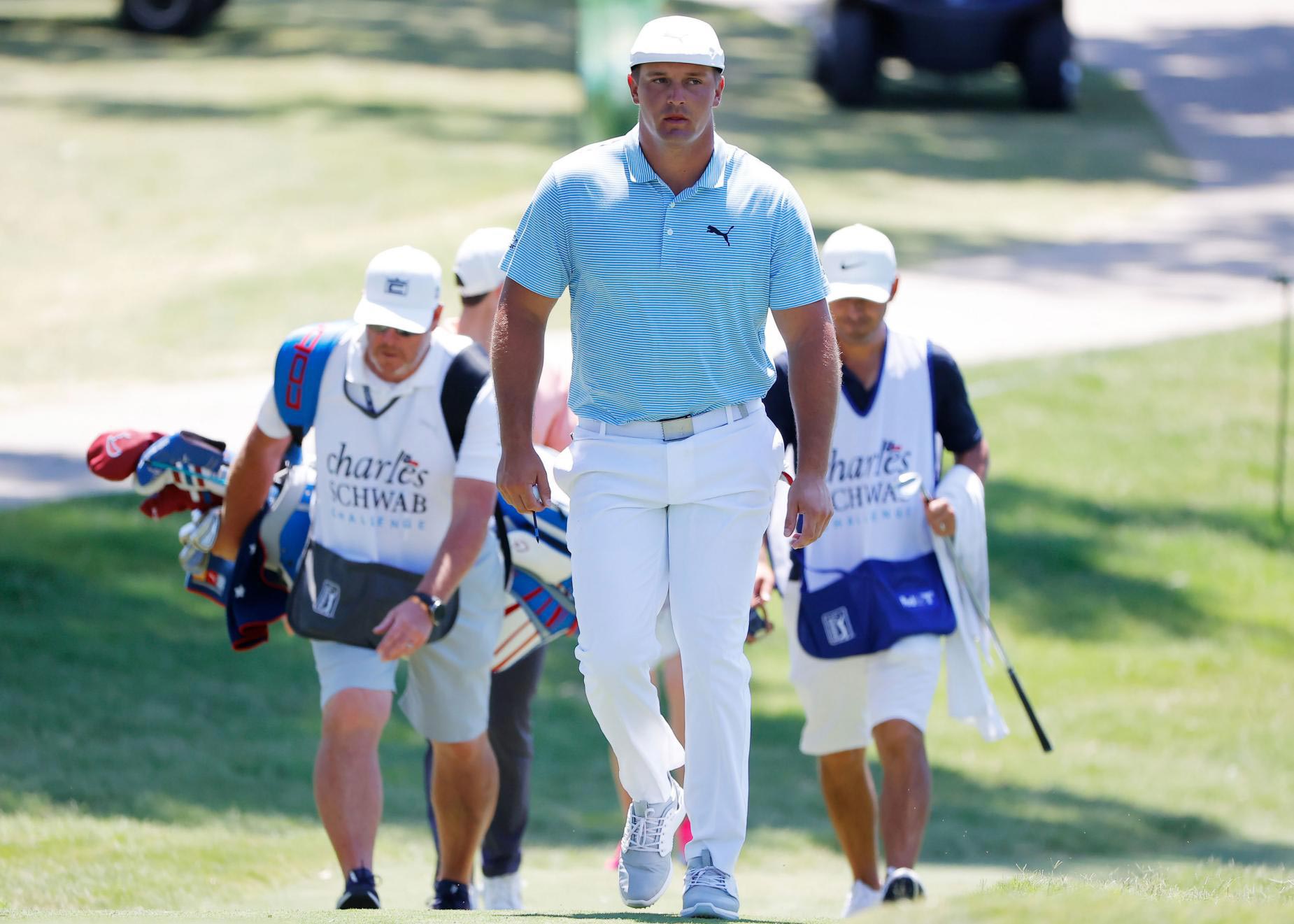It’s unclear whether Bryson DeChambeau was a polarising figure from birth – we’d have to ask his parents, and they might not appreciate the question – but he’s certainly divided fans since emerging into the public eye as a relentlessly innovative golfer. From equipment to strategy to his own body, DeChambeau has never been afraid to tinker in ways that go against the sport’s inherited wisdom. His latest project, gaining strength and mass by virtue of a comprehensive weight regimen and diet, has touched a nerve like nothing else. To witness the result in person is both strange and awe-inspiring, and the reactions, to put it mildly, are mixed.
Some are excited by the radical, power-based approach, but others fall somewhere on the spectrum between “irritated” and “threatened”. For the naysayers, the most offensive part is that it’s actually working. When the PGA Tour returned after the COVID-19 shutdown, DeChambeau, 26, put together four straight top-10 finishes that culminated in a victory at the Rocket Mortgage Classic. With the added power – his 320.6-metre (350.6-yard) driving average two weekends ago set a PGA Tour record for an event winner – he’s taking the distance revolution to dizzying heights. His success so far has annihilated one of golf’s presumed truisms: a player who adds that much weight and muscle will be restricted in his movement and sacrifice touch.
And so another truism emerges. A chorus of analysts and fans alike believe that DeChambeau can’t maintain this mode of play – hell, this lifestyle – without getting injured. More muscle equals more susceptibility to injury, the thinking goes, and his new body makes him a ticking time bomb. After all, look what happened to Tiger Woods.
It’s a comforting thought for those who feel distinctly uncomfortable watching Bryson transform their favourite sport. But is it true?
To answer that question, we first have to understand exactly what he’s attempting.
Part 1: The Guru
Greg Roskopf would probably hate being called a “guru”. The word implies mystical powers, and his system is very much based on empirical data and real-world results. But if DeChambeau is a fitness revolutionary, Roskopf is his spiritual guide. We spoke on the phone last week after the two had just finished a “tune-up” in Denver (DeChambeau skipped the Workday Charity Open ahead of playing at this week’s Memorial, which he won in 2018).
Roskopf has been at it for 30 years, working with pro sports teams and Hall of Fame athletes Peyton Manning, John Elway and John Stockton, among others, developing the system he now calls “Muscle Activation Techniques”. Describing his work with athletes always runs the risk of over-simplification, but broadly speaking, the MAT is about balance, and the guiding principle is that no muscle on the body is less important than any other. You’ll often hear DeChambeau echoing the idea that each athlete is only as strong as his weakest link, and Roskopf likes to use a car metaphor: he’s performing a kind of alignment for the human body.
Roskopf started as a strength and conditioning coach at Fresno State University, and worked in California and later in Colorado with Mike Schy’s sister. Schy is DeChambeau’s longtime swing coach, and as early as Bryson’s college golf days, the future iconoclast was working in MAT techniques with one of Roskopf’s proteges. DeChambeau sought out Roskopf upon turning pro in 2016, because why not work with the guy who pioneered the whole system? Shortly after they made a connection, though, Roskopf was in a bad traffic accident and suffered a traumatic brain injury. Months later, well into his recovery, DeChambeau reached out again, but Roskopf wasn’t sure if he could do the job.
“Then we can just talk shop,” DeChambeau said. He flew to Colorado, and the two have been working together ever since.
When they began, DeChambeau weighed 86 kilograms – he weighs about 110 now – and Roskopf’s first task was not to add muscle or bulk but simply improve the “communication” between DeChambeau’s muscles and nervous system. This step aimed at helping free DeChambeau from the pain and tightness he was experiencing – in other words, to redress specific weaknesses and work towards the full-body harmony he calls “total body balance”. Trauma to one part of the body tends to inflame and weaken muscles so that they don’t contract, or activate, quite so effectively. Roskopf likens it to loose battery cables, and when you consider that muscles are critical to stabilising joints and preventing injury, those loose cables put the whole body at risk. It’s like walking on ice, he said, fundamentally unstable.
Through a variety of hands-on techniques, Roskopf helped DeChambeau reduce muscle tightness and pain, and once the activation was body-wide, there was a solid biomechanical foundation in place. That meant DeChambeau could start adding muscle in earnest. “He’s stronger now through greater ranges of motion,” Roskopf said, “and he’s gained clubhead speed and ball speed. His flexibility has actually improved since he first came to me in 2016.”
For Roskopf, that’s the key component. DeChambeau can add strength and mass all he wants now – he’s mentioned getting as heavy as 120-125 kilograms – as long as flexibility isn’t sacrificed. There’s no longer a worry about any underlying physical problems. They’ve already “melted the ice”.

“It’s basically a misconception,” Roskopf said. “He looks like a weightlifter, but he’s got the flexibility of a golfer. When you have greater range of motion and greater strength through those ranges of motion, you’re seeing what it does to his game.”
After his Rocket Mortgage win, DeChambeau went back to Colorado for a tune-up. That meant being run through a gamut of exercises and tests, and examining his body movement by movement, muscle by muscle. DeChambeau may say he feels terrific, but through this minute examination – to continue the car metaphor, Roskopf thinks of it as maintenance performed on a stock car in the mechanic’s workshop after a race – they can identify areas of weakness. This is imperative because left unattended, Roskopf says, weakness lead to injury. DeChambeau’s issues when he first came to Colorado, which included limitations in hip motion and spinal rotation, are ones they both want to keep safely in the past.
As far as diet, Roskopf lets DeChambeau run free – by his own reckoning, Bryson drinks up to seven protein shakes each day – with the same important caveat that any added mass doesn’t decrease strength or flexibility.
That’s the comprehensive system they’re employing, and both are quite aware of the risks of injury. For DeChambeau, this is not a mad dash to musclehead status; it’s a carefully considered process that’s been unfolding for years.
Part 2: Does more muscle mean more injuries?
Let’s deal with this question broadly to start. We consulted a handful of experts, and their conclusions were similar.
Greg Wells, PhD in Exercise Physiology, Director of Sports Science at the Canadian Sports Institute, former Director of Sport Science for Golf Canada:
“I don’t think that adding muscle mass is associated with an increased risk of injury. I think that I’d be hard-pressed to find any research evidence to suggest that… if anything, I think that there’s consistent research that shows that if you’re strong, and you’ve got good muscle function, and you’ve got good mobility, that your risk of injury would decrease.”
Nick Potter, Director of High Performance and Sports Science, Duke Basketball:
“A general principle in sport that has gained heightened awareness in recent years, and is supported with an abundance of research, is that strength is good for decreasing risk of injury. If his strengthening program is implemented properly, he should be at less risk of injury when he’s stronger.”
Greg Gatz, Director of Strength & Conditioning for Olympic Sports, University of North Carolina:
“If it’s done appropriately, it’s probably going to keep him healthy.”

The fact is that anyone making a blanket statement that more strength equals more injuries is flat-out wrong. However, that doesn’t mean DeChambeau’s experiment comes without risks.
Potter echoed Roskopf in certain aspects, especially about the importance of a full-body approach. “You need a comprehensive program that enhances strength, mobility, agility and proprioception while integrating the skill element of the game,” he said. “If you lose one element while building strength and power, that’s when you can break down pretty quick.”
Potter compared golf to baseball in the sense that you don’t necessarily get hurt when you’re creating force, but when you’re trying to dissipate it. The rotator cuff, for instance, is mostly responsible for decelerating the arm, and that’s one of the most common injury spots for a baseball pitcher. Similarly, a golf swing designed to generate rotational force and power is most vulnerable when that force has to be stopped.
“It’s like in a car,” Potter said, again sounding eerily like Roskopf. “The faster you are, the more efficient your brakes have to be.”
But if a player like DeChambeau has greater strength and greater range to decelerate after generating great force, everything should balance. That deceleration is accomplished through a combination of mobility and eccentric strength – the strength of a muscle as it lengthens, rather than contracts. Any deficit in either will result in forces being transmitted to bone and ligament throughout the body, and the resulting stresses and injuries depend on how the particular athlete compensates.
Part 4: But what about Tiger?
In golf, this is the great strength hang-up. Tiger got bigger, and Tiger got hurt. It’s all too tempting to make a causation error here. It was Roskopf who came closest to linking the two.
“Yes,” he said, when asked if Tiger’s case might have been an example of uneven training. “As people train, they become dominant, they bench press or they squat or they work their quads and hamstrings, but they don’t work their deep hip rotators or abductors or adductors, and they create imbalances within their body.”
You know the rest: the car is out of alignment, and the harder you drive that unaligned car, the more likely you’ll wreck it.
The other experts didn’t want to comment on Tiger’s case specifically, since they didn’t know his exact regimen, but they warned of the dangers of reading too much into one case.
“If anything,” Wells said, “his strength and conditioning enables him to play golf at the level he plays it at for as long as he has, especially generating that kind of force and power. His fitness probably kept him safe from injury rather than causing injury.”
Injuries also can be complete flukes, as Potter, the Duke basketball sports science director, was reminded when Zion Williamson’s sneaker came apart at the seams during the Duke–UNC game in 2019 and resulted in a knee injury that nobody could have prevented. When something like that happens, everyone from the media to fans to medical staff want to know the “cause”, but sometimes there’s no rationale beyond bad luck. And injuries tend to lead to other injuries, which Potter believes is usually due not to some “magical force that causes injuries”, but poor biomechanics and compensation patterns after the initial injury.
In short, we don’t know exactly why Tiger became injured, or why he kept getting injured, but blaming his strength training is reductive, and comparing him to DeChambeau is to compare apples and oranges.

Part 5: The Insanity Diet
DeChambeau recently gave us a snapshot of his current diet, and the headline is that it features a glut of protein shakes. He listed his food during a typical day, and then estimated that it ran to about “3,000 to 3,500 calories”. Anyone who has attempted a diet for more than a day likely had a good chuckle at that, and Roskopf laughed, too, when the number was mentioned – he and DeChambeau talked about it that day, and Roskopf told him it sounded a lot more like 6,000 calories than 3,000.
As Gatz explained to me, an increase of protein intake helps drive and maintain muscle mass, which would be important for DeChambeau’s structure, particularly when he’s burning so many calories walking on a golf course in hot conditions.
But is that healthy? Is it sustainable? Rachel Manor, the Director of Olympic Sports Nutrition at UNC, politely praised DeChambeau for the consistent routine, since eating on a schedule is a staple of a good competitive diet, but took a more “nuanced” view of the rest.
“The part that might not be sustainable is having the six, seven protein shakes each day,” Manor said. “People have food jags where they consume one food for a period of time, and then outgrow them or get tired of them, so I hope he starts to incorporate more varied snacks… a variety of roots, vegetables, nuts, beans, seeds, proteins, dairy. That way he can keep his protein intake high, but still expand his menu.”
Potential consequences of a limited diet with less than 10 food items, Manor said, can include micronutrient issues like iron deficiency, as well as shortages in calcium, Vitamins D and C, and digestive problems from a lack of fibre intake.
On a general note, while making it clear that she didn’t know DeChambeau’s exact diet, Manor said she wouldn’t encourage purposeful “bulking up” even from a psychological angle.
“I do think sometimes people in the media put a lot of focus on someone’s body size,” Manor said. “Those feelings can be internalised, and athletes can get hyper-focused on body size and nutrition. They can get distracted by their food, and it’s a slippery slope where time and energy wasted on trying to manipulate body size actually causes their performance to suffer. Typically, I try to shift athletes’ focus away from manipulating their body size and instead try to focus on adequate nutrition.”

DeChambeau is attempting a physical feat that looks radical in the golf world. In fact, it’s based on a solid foundation of sports science.
“People think I’ve got all these crazy theories,” he recently told Men’s Health, “but when you really break it down to the root principles of what I’m trying to do, it’s a lot of common sense.”
In the case of his weight gain, he’s right. Roskopf’s baseline theories are backed up by real-world success. The hesitations expressed by experts in the field are elements he’s considered, and that he’s been helping athletes overcome for 30 years. It’s a system based on balance, on retaining flexibility and mobility, and never letting any one muscle group eclipse the others.
Can Bryson DeChambeau get injured? Yes. Anybody can get injured, and it would make a lot of uncomfortable people breathe a sigh of relief. But if it happens, it won’t be because he was reckless in adding muscle and weight. This may seem like cutting-edge stuff – DeChambeau presents himself as a kind of P.T. Barnum figure – but strip away the theatrics and it starts to look eminently sensible. As with a few other things he’s done in this sport, we might be asking the wrong question. It’s not about why he’s doing this. It’s about why nobody else did it first.

